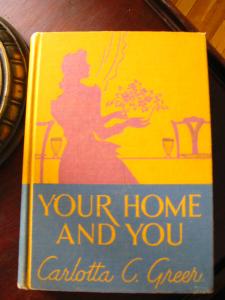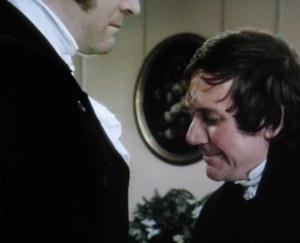After some consideration, I have decided to rerun a series that I wrote on my previous blog. It was a series based on a 1948 Home Economics book that I found during one of my vintage shopping excursions. I adore this book. Although dated in some content, it is spot on for much of today’s living as well as it’s intended 1948 audience. I hope you will enjoy this series. (click here to read my original introduction)
Click here for Lesson One
Click here for Lesson Two
(why fall behind in class?)
The following was originally written on March 9, 2011:

I decided to a little skipping around again with the book. The next chapters dealt more with children and how to care for them. I thought it was interesting that this was part of the curriculum for Home Ec in 1948. Much of the information is presented as to how one would help care for younger siblings. The thought of these young, virtuous minds being fed the idea that they might pro-create one day (once properly married…and for heaven’s sake not while still in school) and bring forth their own children in the world is not even hinted upon. The instruction is more or less presented as “should a baby ever miraculously appear in your life, this is what you do”. Overall the chapters make it plain that children are a lot of work and responsibility. And, of course, regular bowel elimination by the age of 3-4 weeks old is discussed.
Today we will be starting the Unit: SELF-DEVELOPMENT–MANNERS, PERSONALITY, AND VOCATIONS. Our focus today:
THE “HAPPY WAY OF DOING THINGS” (awww.)
“The Basis of Good Manners– Why does a man give his seat in a crowded streetcar to a woman? To make her comfortable. Why, when passing another person on the street, does one step to the right? (i don’t think this is practiced anymore– ever.) To show regard for the rights of another. Why does a person shake hands with another? To show friendliness.
Do you see that the basis of these acts of courtesy is consideration for the comfort, the rights, and the feelings of others? Such consideration is the basis of good manners…” (STOP! What…..<re-read>. Whoa.)
So, in 1948, school aged children were being taught to be caring, empathetic people. “Consideration for the comfort, the rights, and the feelings of others”–this IS NOT the world I live in. Yes, there are random acts of kindness we all experience…but how sad that we call “manners” random acts of kindness. But can you imagine living your day and seeing the following: every man offering a woman (or even an elderly person) his seat on the bus or subway; as you are walking through the mall, there are never any collisions or near misses because everyone is stepping to the right when able; you are introduced to your friend’s teen-aged son/daughter and he/she shakes your hand and then exchanges pleasantries; everyone disposes of his garbage into a trash receptacle. We are talking Utopia here.
The chapter goes on to explain how good manners start at home. It encourages the student to practice good manners with her family. “In the morning when meeting the family, a cheery ‘good morning!’ is one of the common courtesies. ‘May I please, ‘Will you please’ and ‘thank you’ are frequent phrases of the well-bred person. The well-bred person also rarely uses the brief words ‘yes’ and ‘no’. He adds the name of the person to whom the words are spoken, as ‘Yes, Mother’ (I just saw this on an episode of “Father Knows Best”–so it must be true) or ‘No, Mr. Brown’.” How well-bred are you?
Did you know that when two persons are entering a doorway, the younger one pauses to let the other go first? Or a man/boy lets woman/girl go first? Or if you are a hostess, your guest goes through first? Also, a “well-bred” youth rises from his seat when an older person enters the room. A gentleman rises for a lady and a hostess rises for a guest, whether male or female.
![darcy_lizzie396_396x222[1] vintage ~~ your home and you (1948 meets today) #3a](http://m5.paperblog.com/i/57/575065/vintage-your-home-and-you-1948-meets-today-3a-L-f7A3Ph.jpeg)
(photo credit BBC) we well remember the importance of a “proper introduction” from these two and their associates
The next section covers “Introductions”–and let me tell you, this was a lot of information to remember, especially for a woman (namely Moi) who is happy to just remember the names of the people she is introducing let alone the properorder to do this. However precise the rules may be, Ms. Greer assures, “…making a proper introduction is not really difficult at all, if a person puts his mind to it”. So, wrap your mind around this:
The Presentation: “A man or boy should always be presented to a woman…If two women are being introduced, the younger should be presented to the older…If a person of prominence is being introduced to one of less importance, the latter should be presented to the former…An unmarried woman, unless especially prominent, is presented to a married woman…It is well to remember that the name of a person to whom another is presented is always mentioned first in an introduction.” (ex: “Mrs. Littleton, may I present Mr. Gray?”)

a big “non, non!!”
The Response: “Of the two persons being introduced, the one to whom another is presented makes the first response by saying ‘How do you do.’ This person may bow (love it!), or she may extend her hand.” And of course the other person should reciprocate this gesture.
The Conclusion: I found this very useful, “…two strangers who may meet are certainly more comfortable if they are given a clue as to what to say after the formalities of an introduction are over. Thus the gracious thing for the one doing the introducing is briefly to tell something which will make the persons being introduced know more about each other…With this cue, it would be easy for the two persons just introduced to begin an interesting conversation.” Isn’t that charming? No one enjoys an awkward silence.
I think the most enjoyable way to learn all of these etiquettes would be to have a Jane Austen movie marathon. Or regularly watch movies from the 30s, 40s and 50s to get acquainted with these social graces. It’s raining and depressing out today…what am I waiting for?
Our next lesson will finish up this chapter with an emphasis on parties and being a proper hostess. Until then, continue doing things the “happy way”.
I hope you are looking forward to the next lesson. Please do not be alarmed if you do not see it here on next Monday…it will turn up soon there after.~~Heather~~